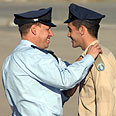

The investigation into the F-16 fighter jet crash which led to the death of Captain Asaf Ramon, the son of Israeli astronaut Ilan Ramon, will be lengthy and complex, sources in the Air Force estimate.
Despite looking into all possible leads, it appears that special attention will be given to explanations of sudden loss of consciousness or human error. "It is possible we may never know what happened exactly," a military source said.
For over a year the IDF examined the circumstances of the terrible accident which occurred in October 2008 when a Zukit Fouga Magister crashed over a creek during a training exercise. The incident claimed the life of Captain Matan Assa and Second Lieutenant Cadet Elan Carmi. Only recently the incident received closure after investigators established that the accident was caused due to human error.
Sunday night elements in the IAF had difficulties estimating how long it would take to ascertain the reason for the F-16 crash, however they suggested that the investigation would be lengthy.
IAF forces will continue their searches Monday for the fighter jet's remains, which according to testimonies had spread across a long distance. An initial examination of the aircraft's history did not reveal suspicious signs and no irregular incidents were reported in connection to it.
The fact that prior to the crash Ramon did not report any unusual activity over the radio, as well as the fact that parts of the plane had scattered to all directions will put a strain on the investigation committee's efforts to get a clear idea of what happened, IAF sources said.
The examination process will include a computer simulation which will factor in all of the information collected and the various possible outlines for the accident.
'No stone left unturned'
In the meantime all leads are being looked into. A technical malfunction explanation would be easier to trace and corroborate. "In these sorts of tests, no stone is left unturned, every piece of information is being checked in the most sophisticated laboratories by the best in the business," a military source explained.
Other leads such as human error, which might have led to the sudden dive downwards or a sudden medical problem that may have caused the pilot to lose consciousness are being examined. The fact that Ramon had practiced in the same outline before and was considered an excellent pilot, which is supported by his recent performances, decreases the chances that the accident was caused by an error on his part.
"As one rules out chances of technical malfunctions the personal aspect will become more likely, which may prolong the investigation, but things don't always unfold this way," the military source said.















